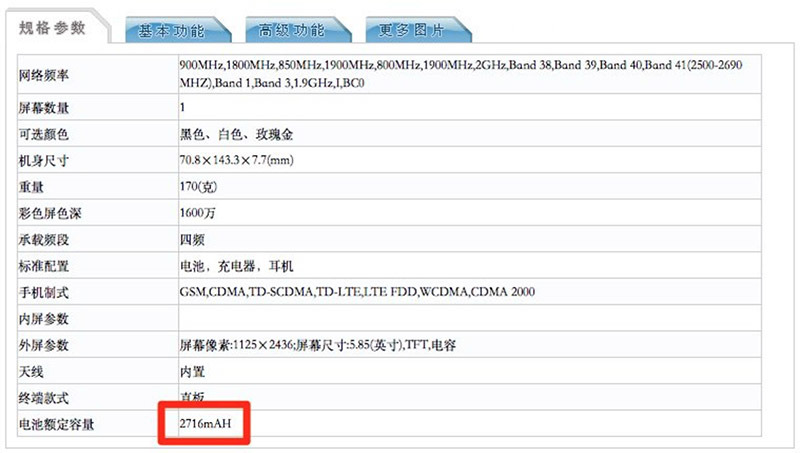A filing with the Chinese Ministry of Industry and Information Technology's Telecommunication Equipment Certification Center (TENAA) appears to show specifications for Apple's iPhone X, notably a capacious 2,716 milliamp-hour battery that will power an A11 Bionic chip clocked at 2.4GHz.
The documents, spotted on Tuesday by avid leaker Steve Hemmerstoffer, offer a sneak peek at the upcoming flagship iPhone prior to its release in November. So far, Apple has been less than forthcoming regarding device specifications, opting only to focus on major hardware features in its promotional material.
According to the electronic filing, however, iPhone X packs in a massive 2,716mAh battery. By comparison, the iPhone 8 Plus carries a 2,691mAh cell, while the smaller iPhone 8 makes do with a 1,821mAh unit.
The extra capacity is likely an operating requirement for iPhone X's TrueDepth depth-sensing camera, the backbone of Apple's new Face ID facial recognition system. Another power-hungry component unique to iPhone X is a dual-camera array that boasts optical image stabilization mechanisms on both lenses instead of the usual single wide angle shooter.
Despite being an OLED component, the full-face 5.8-inch Super Retina screen might also draw more power than a typical iPhone display. Traditional LCD displays like those used on all iPhone models up to iPhone X are transmissive in that a backlight is constantly emitting energy to push light through individual pixels, which subsequently change color to present onscreen images. OLED, on the other hand, is an emissive technology, meaning each individual pixel is its own light source. As it pertains to power consumption, a black pixel consumes no energy because it is switched off.
For these and other reasons, OLED technology is more efficient than LCD, though the larger format on iPhone X, and as-yet-unknown tweaks to the handset's display controller, might mean it draws more power than iPhone 8 Plus.
In addition, the TENAA documents appear to show an A11 Bionic chip clocked at 2.4GHz, nearly identical to iPhone 8 and 8 Plus benchmarks. Interestingly, the iPhone X sports the same amount of RAM as its 8-series stablemates, suggesting Apple fine tuned the flagship's tentpole features — Face ID, unique user interface — to run with minimal overhead.
Preorders for iPhone X are slated to go live on Oct. 27 at 12:01 a.m. Pacific, ahead of public release on Nov. 3.
 Mikey Campbell
Mikey Campbell







-m.jpg)






 Brian Patterson
Brian Patterson
 Charles Martin
Charles Martin


 Malcolm Owen
Malcolm Owen
 William Gallagher
William Gallagher
 Christine McKee
Christine McKee
 Marko Zivkovic
Marko Zivkovic









23 Comments
Why aren't these battery capacities precisely in multiples of 10 (or powers of 10)? Isn't that how the universe works?
I had to laugh at this statement "
Compared to android phones this is still quite small, expect between 3000 up to 5000 for the green robot brigade.
That is a seriously meaty wedge of guesswork.
What to expect, from an Apple based Fansite.
If with a battery that is almost twice what the 8 and 8+ have, this phone doesn't achieve more than a day's worth, it is quite a letdown.
Does really the FaceID need so much power that a full 1000mAh extra are necessary to achieve a 1-day usage on the X?
Whether the OLED vs LED discussion yields that the former is more/less power hungry than the latter, I'd like to see more technical data about the 2 technologies. (i.e. 1cm2 of LED at 600nits with image X, consumes so and so much less/more than an 1cm2 OLED displaying the same).